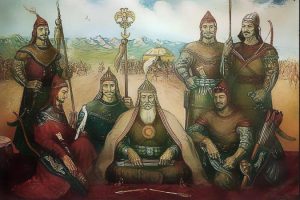
Adolf Hitler grew up in Linz, Austria, in a middle-class family. He showed little interest in academics but had a passion for painting. Unfortunately, his dreams of becoming an artist were shattered when he was rejected twice by the Vienna Academy of Fine Arts. These rejections fueled his resentment and led to a period of poverty and homelessness in Vienna.
In 1913, Hitler moved to Munich, Germany, where he became involved in politics. Following Germany’s defeat in World War I, Hitler’s resentment towards the Treaty of Versailles and the Weimar Republic intensified. In 1920, he joined the National Socialist German Workers’ Party, later known as the Nazi Party. Hitler’s charismatic personality and powerful oratory skills helped him gain popularity, and he eventually became the party’s leader.
Hitler’s rise to power came in 1933 when he was appointed as Chancellor of Germany. Exploiting the economic turmoil and widespread discontent, he swiftly consolidated his authority. Once in power, Hitler implemented a series of policies that aimed to establish an Aryan master race. The persecution of Jews, homosexuals, disabled individuals, and other minority groups became rampant.
The Holocaust, one of the darkest periods in history, occurred under Hitler’s regime. The Nazi regime systematically exterminated six million Jews and millions of others in concentration camps, where they faced unimaginable horrors. Hitler’s anti-Semitic ideology and his pursuit of ethnic cleansing were central to his vision for Germany and Europe.
Hitler’s foreign policy was aggressive and expansionist. He sought to create Lebensraum (living space) for the German people by annexing territories and subjugating other nations. In 1938, Hitler orchestrated the annexation of Austria, known as the Anschluss. Subsequently, he pursued territorial claims in Czechoslovakia, which culminated in the Munich Agreement.
In 1939, Hitler’s invasion of Poland marked the beginning of World War II. The conflict engulfed Europe, leading to the deaths of millions and immense destruction. Hitler’s military strategies and the brutal tactics employed by the Nazi regime, such as the Blitzkrieg, caused widespread devastation.
As the war progressed, Hitler’s leadership and decision-making came under scrutiny. Costly military campaigns, such as the invasion of the Soviet Union, resulted in heavy casualties for German forces. The tide turned against Germany, and Allied forces began to gain ground. Despite Hitler’s stubborn resistance, the fall of Berlin in 1945 signaled the end of the Nazi regime.
Realizing that defeat was imminent, Hitler took his own life on April 30, 1945, in his bunker in Berlin. The legacy he left behind was one of destruction, suffering, and the horrors of war. The world had witnessed the atrocities committed under his rule and vowed to ensure that such a tragedy would never happen again.
The Nuremberg Trials held after World War II brought many Nazi leaders, including Hitler’s top associates, to justice. The trials established important principles in international law and held individuals accountable for crimes against humanity.
Adolf Hitler’s life and actions serve as a stark reminder of the dangers of hatred, racism, and unchecked power. His ideology and the crimes committed under his regime remain a testament



















Add Comment